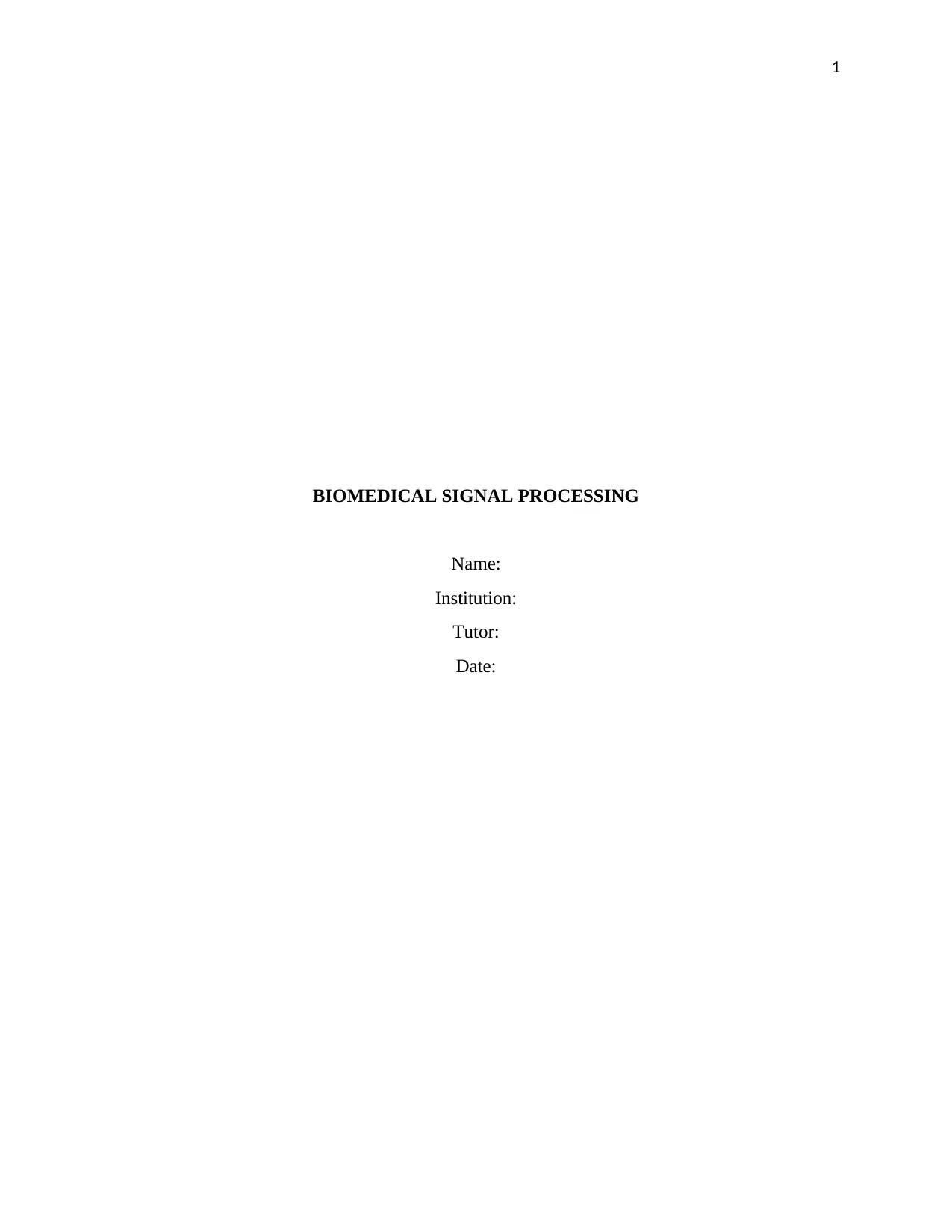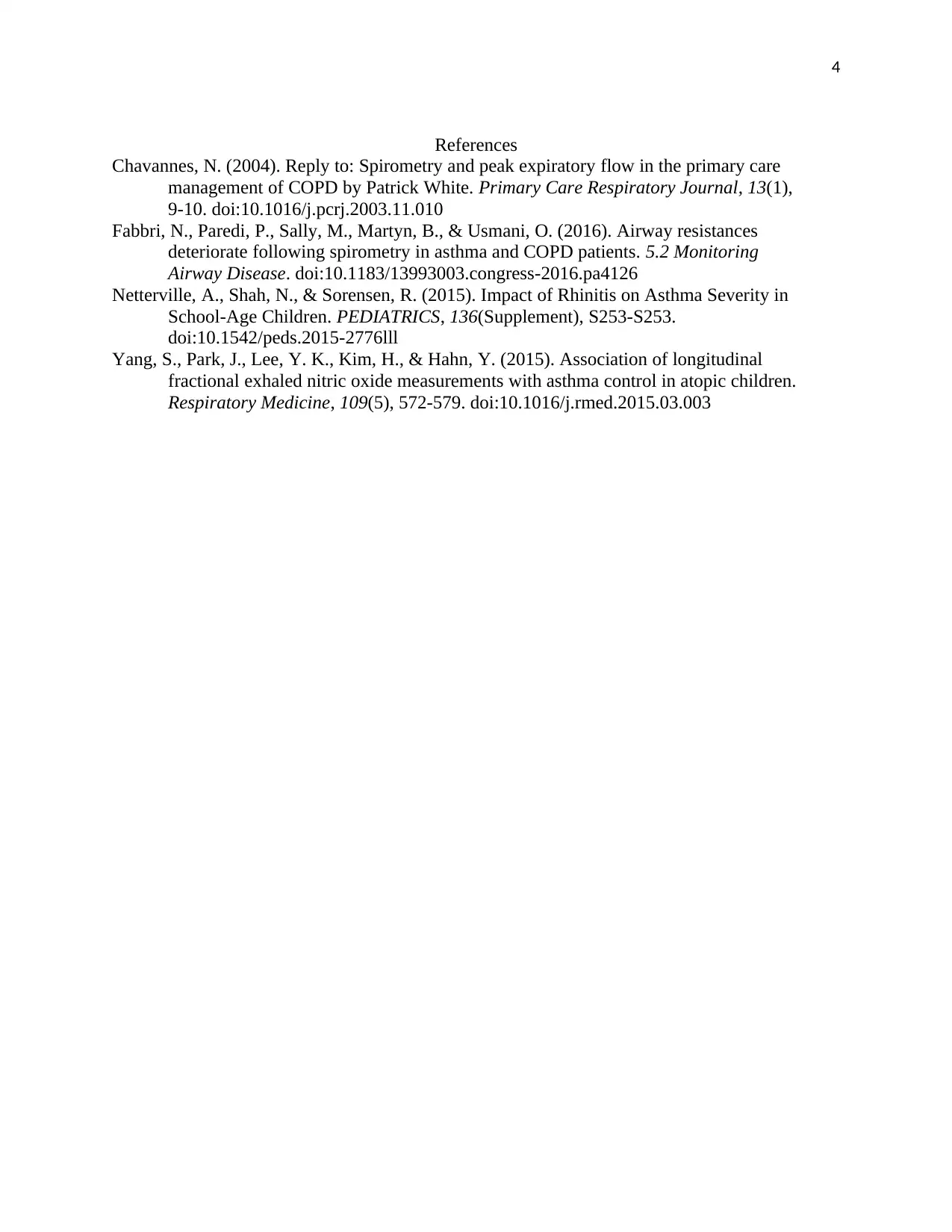Addressing Spirometer Limitations in Asthma and COPD Diagnosis
VerifiedAdded on 2023/06/11
|4
|907
|354
Report
AI Summary
This report explores the limitations of spirometry in diagnosing asthma and Chronic Obstructive Pulmonary Disease (COPD). It highlights the issue of false negative results, citing a study where a significant number of participants with asthma or COPD symptoms received normal spirometry readings. The report identifies research gaps in spirometer application and proposes research questions focused on eliminating false negatives and exploring alternative diagnostic techniques for asthma and COPD. It concludes that while spirometry is a preferred method, further research is needed to address its limitations and improve diagnostic accuracy. Desklib provides access to similar solved assignments and past papers for students.

1
BIOMEDICAL SIGNAL PROCESSING
Name:
Institution:
Tutor:
Date:
BIOMEDICAL SIGNAL PROCESSING
Name:
Institution:
Tutor:
Date:
Paraphrase This Document
Need a fresh take? Get an instant paraphrase of this document with our AI Paraphraser

2
Biomedical signal processing
INTRODUCTION
Both airflow and lung volume measurements are usually used to differentiate between
obstructive and restrictive pulmonary infections so that the severity of the condition can be well
characterized. These two measurements can also be used to estimate the response to treatment
(Fabbri, Paredi, Sally, Martyn, & Usmani, 2016, p. 12). Airflow can be defined as the
quantitative measures of both the inspiratory and expiratory flow that are usually obtained during
a forced respiration. The nose clips are usually applied so that the nares are exclusively
occluded.The gaps that exist when using spirometry is false negative results.
Gaps in the use of spirometers to diagnose Asthma.
Despite several studies advocating for the use of spirometers to diagnose asthma, there
still exists several gaps with this method. One such significant gaps is the false negative results
associated with the spirometer.The spirometer according to several research, is the standard
method to measure how the lungs are functioning (Yang, Park, Lee, Kim, & Hahn, 2015, p. 576).
The procedure of carrying out spirometry involves measuring the weight and height initially and
then breathing into the machine when the nose is clipped. The patient then blows out as fast as
possible until the lungs are completely filled. This usually takes some few seconds.
A simple spirometer
The spirometer measures Forced expiratory volume in a second (FEV1), the Forced vital
capacity (FVC) and the FEV1 divided by FVC.FEV1 is defined as the quantity of air one can
blow out in a second. Under normal circumstances, one is supposed to blow out so much air
from the lungs in a single second. FVC on the other hand is the quantity of air that one can blow
out in a single breath. The spirometry readings or results usually display normal, an obstructive
pattern, a restrictive pattern and finally a combination of both the obstructive and restrictive
pattern.
Based on the above explanations, it is very clear that the spirometer test is used to
diagnose as well as treating different conditions like asthma and the Chronic Obstructive
Pulmonary Disease. However, where there are several gaps is that despite the spirometer
showing or rather displaying normal results sometimes, it does not necessarily rule out some
Biomedical signal processing
INTRODUCTION
Both airflow and lung volume measurements are usually used to differentiate between
obstructive and restrictive pulmonary infections so that the severity of the condition can be well
characterized. These two measurements can also be used to estimate the response to treatment
(Fabbri, Paredi, Sally, Martyn, & Usmani, 2016, p. 12). Airflow can be defined as the
quantitative measures of both the inspiratory and expiratory flow that are usually obtained during
a forced respiration. The nose clips are usually applied so that the nares are exclusively
occluded.The gaps that exist when using spirometry is false negative results.
Gaps in the use of spirometers to diagnose Asthma.
Despite several studies advocating for the use of spirometers to diagnose asthma, there
still exists several gaps with this method. One such significant gaps is the false negative results
associated with the spirometer.The spirometer according to several research, is the standard
method to measure how the lungs are functioning (Yang, Park, Lee, Kim, & Hahn, 2015, p. 576).
The procedure of carrying out spirometry involves measuring the weight and height initially and
then breathing into the machine when the nose is clipped. The patient then blows out as fast as
possible until the lungs are completely filled. This usually takes some few seconds.
A simple spirometer
The spirometer measures Forced expiratory volume in a second (FEV1), the Forced vital
capacity (FVC) and the FEV1 divided by FVC.FEV1 is defined as the quantity of air one can
blow out in a second. Under normal circumstances, one is supposed to blow out so much air
from the lungs in a single second. FVC on the other hand is the quantity of air that one can blow
out in a single breath. The spirometry readings or results usually display normal, an obstructive
pattern, a restrictive pattern and finally a combination of both the obstructive and restrictive
pattern.
Based on the above explanations, it is very clear that the spirometer test is used to
diagnose as well as treating different conditions like asthma and the Chronic Obstructive
Pulmonary Disease. However, where there are several gaps is that despite the spirometer
showing or rather displaying normal results sometimes, it does not necessarily rule out some

3
forms of the lung diseases. This is in accordance to a research that was carried out by the
University Of Minnesota Department Of Health Sciences where 256 participants were enrolled
in a study (Chavannes, 2004, p. 13). The participants exhibited symptoms of asthma and chronic
Obstructive Pulmonary Disease. Out of the 256 participants, it is only 78 whom the spirometer
recorded results as being either asthmatic or positive of COPD (Netterville, Shah, & Sorensen,
2015, p. 12).This therefore clearly demonstrates that there are wide discrepancies in the
measurements obtained when using spirometers. Researchers therefore ought to go back to the
drawing board and come up with better methods to diagnose, assess and treat asthma and chronic
Obstructive Pulmonary Diseases. They can as well come up with strategies on how to bridge the
identified gaps.
Research questions
Based on the above explanations, it is evident that there are some gaps with the
application of spirometry in diagnosing and treating asthma as well as chronic Obstructive
Pulmonary Disease. There should therefore be extensive research to bridge those gaps. The
research questions in this case would be
1. How can false negative results be eliminated when using spirometers in treatment and
diagnosis of asthma?
2. What other better techniques that can be used to diagnose and treat asthma and chronic
obstructive pulmonary disease?
CONCLUSION
Spirometer is an apparatus used to diagnose and treat asthma as well as chronic
obstructive pulmonary disease. Despite being the most preferred method, it has gaps like give
giving false negative results as illustrated in a study explained earlier. Scientists therefore ought
to go back to the drawing board and come up with ways on how to bridge those gaps.
forms of the lung diseases. This is in accordance to a research that was carried out by the
University Of Minnesota Department Of Health Sciences where 256 participants were enrolled
in a study (Chavannes, 2004, p. 13). The participants exhibited symptoms of asthma and chronic
Obstructive Pulmonary Disease. Out of the 256 participants, it is only 78 whom the spirometer
recorded results as being either asthmatic or positive of COPD (Netterville, Shah, & Sorensen,
2015, p. 12).This therefore clearly demonstrates that there are wide discrepancies in the
measurements obtained when using spirometers. Researchers therefore ought to go back to the
drawing board and come up with better methods to diagnose, assess and treat asthma and chronic
Obstructive Pulmonary Diseases. They can as well come up with strategies on how to bridge the
identified gaps.
Research questions
Based on the above explanations, it is evident that there are some gaps with the
application of spirometry in diagnosing and treating asthma as well as chronic Obstructive
Pulmonary Disease. There should therefore be extensive research to bridge those gaps. The
research questions in this case would be
1. How can false negative results be eliminated when using spirometers in treatment and
diagnosis of asthma?
2. What other better techniques that can be used to diagnose and treat asthma and chronic
obstructive pulmonary disease?
CONCLUSION
Spirometer is an apparatus used to diagnose and treat asthma as well as chronic
obstructive pulmonary disease. Despite being the most preferred method, it has gaps like give
giving false negative results as illustrated in a study explained earlier. Scientists therefore ought
to go back to the drawing board and come up with ways on how to bridge those gaps.
⊘ This is a preview!⊘
Do you want full access?
Subscribe today to unlock all pages.

Trusted by 1+ million students worldwide

4
References
Chavannes, N. (2004). Reply to: Spirometry and peak expiratory flow in the primary care
management of COPD by Patrick White. Primary Care Respiratory Journal, 13(1),
9-10. doi:10.1016/j.pcrj.2003.11.010
Fabbri, N., Paredi, P., Sally, M., Martyn, B., & Usmani, O. (2016). Airway resistances
deteriorate following spirometry in asthma and COPD patients. 5.2 Monitoring
Airway Disease. doi:10.1183/13993003.congress-2016.pa4126
Netterville, A., Shah, N., & Sorensen, R. (2015). Impact of Rhinitis on Asthma Severity in
School-Age Children. PEDIATRICS, 136(Supplement), S253-S253.
doi:10.1542/peds.2015-2776lll
Yang, S., Park, J., Lee, Y. K., Kim, H., & Hahn, Y. (2015). Association of longitudinal
fractional exhaled nitric oxide measurements with asthma control in atopic children.
Respiratory Medicine, 109(5), 572-579. doi:10.1016/j.rmed.2015.03.003
References
Chavannes, N. (2004). Reply to: Spirometry and peak expiratory flow in the primary care
management of COPD by Patrick White. Primary Care Respiratory Journal, 13(1),
9-10. doi:10.1016/j.pcrj.2003.11.010
Fabbri, N., Paredi, P., Sally, M., Martyn, B., & Usmani, O. (2016). Airway resistances
deteriorate following spirometry in asthma and COPD patients. 5.2 Monitoring
Airway Disease. doi:10.1183/13993003.congress-2016.pa4126
Netterville, A., Shah, N., & Sorensen, R. (2015). Impact of Rhinitis on Asthma Severity in
School-Age Children. PEDIATRICS, 136(Supplement), S253-S253.
doi:10.1542/peds.2015-2776lll
Yang, S., Park, J., Lee, Y. K., Kim, H., & Hahn, Y. (2015). Association of longitudinal
fractional exhaled nitric oxide measurements with asthma control in atopic children.
Respiratory Medicine, 109(5), 572-579. doi:10.1016/j.rmed.2015.03.003
1 out of 4
Related Documents
Your All-in-One AI-Powered Toolkit for Academic Success.
+13062052269
info@desklib.com
Available 24*7 on WhatsApp / Email
![[object Object]](/_next/static/media/star-bottom.7253800d.svg)
Unlock your academic potential
Copyright © 2020–2025 A2Z Services. All Rights Reserved. Developed and managed by ZUCOL.





